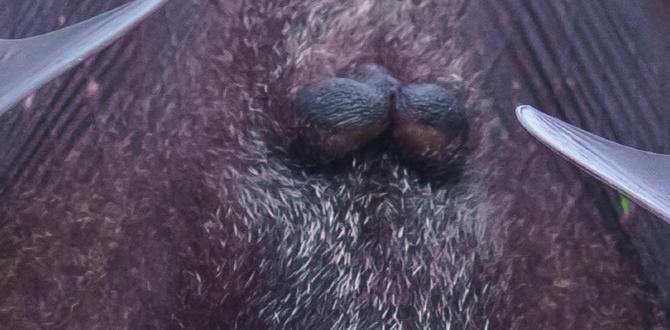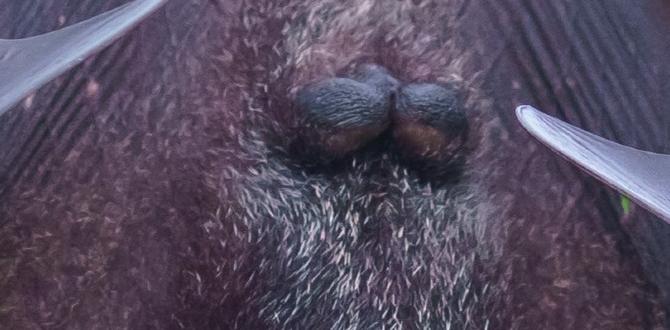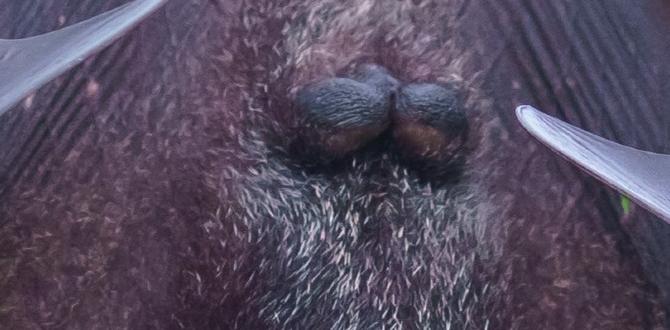All About Bats For Kids: Fun Facts And Learning Opportunities

All About Bats for Kids
Bats are fascinating creatures that can fly and help our environment. Did you know they are the only mammals that can do this? These nocturnal animals use echolocation to find food in the dark. They eat insects, fruit, and even small animals! Bats also play a crucial role in pollinating plants and spreading seeds. Learning about bats helps us understand their importance. So, the next time you see one, remember they are more than just spooky creatures of the night!What are Bats?
Definition and basic characteristics. Different species of bats.Bats are fascinating animals. They belong to a group called mammals, which means they are warm-blooded and have fur. Bats are known for their wings, helping them fly at night. They use sonar to find food. There are many species of bats, each unique and special. Here’s a look at some types:
- Fruit Bats: They eat fruits and are often large.
- Insectivorous Bats: They eat insects and are usually small.
- Vampire Bats: They drink blood, but only from animals.
With over 1,400 species, bats are important for our ecosystem!
What do bats eat?
Bats eat fruits, insects, and even blood, depending on the species.Habitat of Bats
Common places where bats live. How they adapt to different environments.Bats are amazing creatures that find homes in many places. Common places where they live include:
- Caves
- Trees
- Buildings
- Bridges
These animals can adapt to different environments. They find places that are dark and safe. This keeps them away from predators. Did you know that some bats can live in cold areas while others thrive in warm places? Bats are skilled at choosing the best habitats for their needs!
Where do bats typically live?
Bats often live in caves or hollow trees. They also like attics and old buildings as safe spots to rest. Some bats even hang under bridges!
How do bats adapt to different environments?
Bats can change their living habits easily. They can survive in various climates. This helps them find food and stay safe.
Life Cycle of Bats
Stages of bat development. Birth and parental care.Bats go through some fun stages as they grow up! They start as tiny babies that are born upside down. Can you imagine that? Newborn bats cling to their moms for warmth and food. Parental care is super important; mother bats feed their young milk just like us! As they grow, they learn to fly and hunt for insects. Isn’t it funny to think about a baby bat in training to be a nighttime superhero? Below is a simple table showing the stages of bat development:
| Stage | Description |
|---|---|
| Birth | Born upside down, usually one pup at a time. |
| Parental Care | Fed milk and kept warm by the mother. |
| Growth | Grows strong and learns to fly and hunt. |
Fun fact: A mother bat can recognize her pup’s squeak! That’s some serious mom superpower!
Interesting Facts about Bats
Unique abilities and traits. Fun trivia that amazes kids.Bats are amazing creatures with some unique abilities! They can see well in the dark, using echolocation to find food and avoid obstacles. Did you know some bats can eat up to 1,200 mosquitoes in one hour? That’s a lot of bugs! Here are more fun facts:
- Some bats can fly over 60 miles per hour!
- They are the only flying mammals.
- Bats play a big role in plants’ growth by spreading seeds.
With wings made of skin, they can squeeze into tiny spaces. Isn’t that cool?
What do bats eat?
Bats eat insects, fruits, and even small animals. Some bats love nectar from flowers!
Myths and Misconceptions about Bats
Common misconceptions debunked. Importance of understanding bats.Many people have strange ideas about bats. Some think they are all dangerous or will attack you. This isn’t true! Bats are friendly and help the environment. They eat lots of bugs, like mosquitoes, and pollinate plants. This is good for nature. Understanding bats means we respect them. Here are some common myths:
- Bats are blind.
- All bats carry rabies.
- Bats are related to mice.
By learning the truth, we can appreciate these amazing creatures. They are vital for our ecosystem!
Why are bats important?
Bats help control insect populations and support plant growth. Their role in nature keeps our environment healthy.
Bats in Culture and Folklore
Bats in stories and legends. Symbolism and significance in different cultures.Bats have fluttered their way into many stories and legends. In certain cultures, they are seen as symbols of change and rebirth. Ancient Chinese tales often view bats as lucky creatures. Did you know that in Mexico, they celebrate bat-related festivals? These little flyers are more than just winged mammals; they connect different cultures in surprising ways. It’s like they hang upside-down, listening to tales from below!
| Culture | Significance |
|---|---|
| Chinese | Symbol of good luck |
| Mexican | Celebrated in festivals |
| European | Linked to witchcraft |
How to Help Bats
Ways kids can contribute to bat conservation. Creating batfriendly habitats.Helping bats can be fun and easy! Kids can plant native flowers. These flowers attract insects, which bats love to eat. Building a bat house is another great idea. It gives bats a place to rest. Cleaning up trash keeps their homes safe too. Don’t forget to tell friends about bats! The more we know, the better we can help them flourish. Remember, if we help bats, they can help us by eating pesky bugs. Isn’t that a win-win? Here’s a simple table on how to help:
| Activity | Description |
|---|---|
| Plant Flowers | Grow plants that attract bugs for bats. |
| Build Bat Houses | Offer bats a cozy spot to chill. |
| Clean Up | Pick up trash in natural areas. |
| Spread the Word | Teach others why bats are important! |
Conclusion
In conclusion, bats are fascinating creatures that can fly, eat insects, and help plants grow. You learned they use echolocation to find food and have unique habitats. Explore more about bats by visiting your local library or watching videos online. Remember, learning about nature can be fun, and every little bit helps us appreciate the world around us!FAQs
Sure! Here Are Five Questions Related To Bats That Are Suitable For Kids:Sure! Here are five fun questions about bats: 1. **What do bats eat?** Bats eat insects, fruit, and nectar. Some even eat fish! 2. **Where do bats live?** Bats live in caves, trees, and buildings. They like dark, safe places. 3. **Are bats blind?** No, bats are not blind! They can see, but they also use sound to find food. 4. **How do bats sleep?** Bats hang upside down while they sleep. This helps them stay safe from predators. 5. **Can bats help the environment?** Yes, bats help control insect populations and pollinate plants. They are great for nature!
Sure! Please provide the question you want me to answer.
What Do Bats Eat, And How Do They Find Their Food In The Dark?Bats mostly eat insects, fruit, or nectar. Some bats even catch fish! They find food in the dark by using a special skill called echolocation. This means they make high sounds that bounce off things around them. By listening to the echoes, bats know where their food is hiding.
Why Are Bats Important For The Environment And How Do They Help Plants Grow?Bats are important because they help pollinate plants and spread seeds. When bats eat fruit, they carry the seeds away and drop them, helping new plants grow. They also eat insects, like mosquitoes, which keeps nature balanced. Without bats, many plants and animals could be in trouble!
How Do Bats Use Echolocation To Navigate And Avoid Obstacles?Bats use echolocation to find their way in the dark. They make sounds that bounce back off things. When the sounds return, bats listen carefully. This helps them know where objects are. By using echolocation, they can fly safely without bumping into anything.
What Are Some Common Types Of Bats, And Where Do They Usually Live?Some common types of bats are little brown bats, big brown bats, and fruit bats. Little brown bats like to live in caves and old buildings. Big brown bats often roost in trees or attics. Fruit bats can be found in warm, tropical areas, often in big groups. Bats are really important because they help pollinate plants and eat insects.
Are All Bats Scary, Or Are There Friendly Ones That People Can Learn About And Appreciate?Not all bats are scary! Some bats are very friendly and helpful. For example, fruit bats eat fruit and help plants grow. Bats also eat a lot of insects, which keeps our gardens healthy. If we learn more about bats, we can appreciate how cool they really are!
{“@context”:”https://schema.org”,”@type”: “FAQPage”,”mainEntity”:[{“@type”: “Question”,”name”: “Sure! Here Are Five Questions Related To Bats That Are Suitable For Kids:”,”acceptedAnswer”: {“@type”: “Answer”,”text”: “Sure! Here are five fun questions about bats: 1. **What do bats eat?** Bats eat insects, fruit, and nectar. Some even eat fish! 2. **Where do bats live?** Bats live in caves, trees, and buildings. They like dark, safe places. 3. **Are bats blind?** No, bats are not blind! They can see, but they also use sound to find food. 4. **How do bats sleep?** Bats hang upside down while they sleep. This helps them stay safe from predators. 5. **Can bats help the environment?** Yes, bats help control insect populations and pollinate plants. They are great for nature!”}},{“@type”: “Question”,”name”: “”,”acceptedAnswer”: {“@type”: “Answer”,”text”: “Sure! Please provide the question you want me to answer.”}},{“@type”: “Question”,”name”: “What Do Bats Eat, And How Do They Find Their Food In The Dark?”,”acceptedAnswer”: {“@type”: “Answer”,”text”: “Bats mostly eat insects, fruit, or nectar. Some bats even catch fish! They find food in the dark by using a special skill called echolocation. This means they make high sounds that bounce off things around them. By listening to the echoes, bats know where their food is hiding.”}},{“@type”: “Question”,”name”: “Why Are Bats Important For The Environment And How Do They Help Plants Grow?”,”acceptedAnswer”: {“@type”: “Answer”,”text”: “Bats are important because they help pollinate plants and spread seeds. When bats eat fruit, they carry the seeds away and drop them, helping new plants grow. They also eat insects, like mosquitoes, which keeps nature balanced. Without bats, many plants and animals could be in trouble!”}},{“@type”: “Question”,”name”: “How Do Bats Use Echolocation To Navigate And Avoid Obstacles?”,”acceptedAnswer”: {“@type”: “Answer”,”text”: “Bats use echolocation to find their way in the dark. They make sounds that bounce back off things. When the sounds return, bats listen carefully. This helps them know where objects are. By using echolocation, they can fly safely without bumping into anything.”}},{“@type”: “Question”,”name”: “What Are Some Common Types Of Bats, And Where Do They Usually Live?”,”acceptedAnswer”: {“@type”: “Answer”,”text”: “Some common types of bats are little brown bats, big brown bats, and fruit bats. Little brown bats like to live in caves and old buildings. Big brown bats often roost in trees or attics. Fruit bats can be found in warm, tropical areas, often in big groups. Bats are really important because they help pollinate plants and eat insects.”}},{“@type”: “Question”,”name”: “Are All Bats Scary, Or Are There Friendly Ones That People Can Learn About And Appreciate?”,”acceptedAnswer”: {“@type”: “Answer”,”text”: “Not all bats are scary! Some bats are very friendly and helpful. For example, fruit bats eat fruit and help plants grow. Bats also eat a lot of insects, which keeps our gardens healthy. If we learn more about bats, we can appreciate how cool they really are!”}}]}






